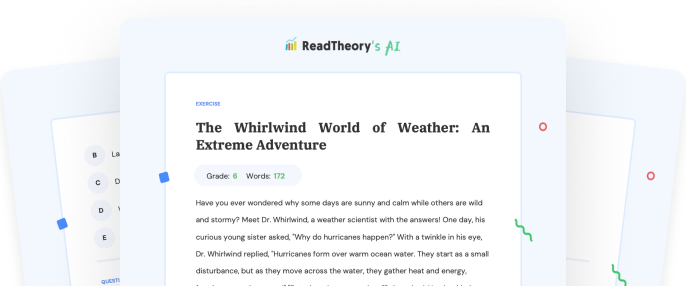Transform Your Teaching
with AI-Powered Worksheets
With ReadTheory’s Instant Worksheet Builder, you can create engaging, grade-appropriate worksheets tailored to your students in minutes. Spark curiosity, save time, and empower critical thinking with AI-powered tools designed for teachers like you.


The Life Story of a Hurricane
Do you know the birth story of a hurricane? It all starts in the warm waters near the equator. As the sun heats the ocean surface, the water evaporates, creating a low pressure area. The surrounding high pressure air rushes in, but due to the Coriolis effect, it starts to spin, thus giving birth to a hurricane. As the hurricane grows, it feeds off the heat energy and moisture from the warm ocean. With winds blowing at over 74 miles per hour, its power is enormous. The eye, however, remains calm, a stark contrast to the swirling destruction that surrounds it. Hurricanes journey across the ocean, often making landfall, where they unleash their fury. They flatten houses, uproot trees, and flood communities. However, amidst the destruction, they also play a role in reshaping the earth's landscape. They erode beaches, form new waterways, and redistribute sediments. Moreover, hurricanes impact wildlife in profound ways. They can disrupt habitats, but they can also create new ones. Some species benefit, while others struggle to survive. It's a testament to nature's resilience and the delicate balance it maintains. Eventually, the hurricane weakens. It may collide with a mountain range or veer into colder waters. Deprived of its warm, watery fuel, the once fearsome storm fades away, leaving only memories and altered landscapes in its wake. In essence, a hurricane is not just a destructive force, but also an agent of change. It embodies the power and unpredictability of nature, reminding us of our place in the grand scheme of things.
Question 1
What is the Coriolis effect?
A natural phenomenon that causes wind and water to curve as it moves across the Earth.
The process of water evaporating from the ocean surface.
A force that allows hurricanes to flatten houses and uproot trees.
The effect of the sun heating the ocean surface.
A force that maintains the calmness of the eye of a hurricane.
Question 2
What is the role of hurricanes in nature?
They only cause destruction and harm to wildlife.
They serve no purpose in nature.
They only form new waterways and redistribute sediments.
They are agents of change that can alter landscapes and impact wildlife.
They help the ocean waters to cool down.
Question 3
What happens when a hurricane hits colder waters or a mountain range?
It gets stronger and creates more destruction.
It keeps its strength but changes direction.
It dies down as it is deprived of its warm, watery fuel.
It turns into a tornado or a different type of storm.
It starts to spin faster due to the Coriolis effect.
Question 4
How are hurricanes formed?
Through the rotation of the Earth around the Sun.
By the sudden drop in the temperature of the ocean waters.
By the sun heating up the ocean surface, causing evaporation, and creating a low-pressure area.
By the interaction of high pressure and low pressure air masses on land.
Through the melting of the polar ice caps.
Question 5
What is the 'eye' of a hurricane?
The most destructive part of the storm.
The area where the wind speeds are the highest.
The calm area in the center of the storm.
The part of the storm that erodes beaches and forms new waterways.
The area where the storm draws its energy from.
 or share via
or share via

Assign the ReadTheory pretest to determine students' reading levels.

Why Teachers Love
Instant Worksheet Builder?

Tailored Content for Every Student
Craft worksheets with passages and multiple-choice questions customized to your chosen topic and grade level, ensuring relevance and engagement.

Save Hours
of Prep Time
Our AI, Lexi, generates complete worksheets—passages, questions, and answers—in minutes, freeing you to focus on teaching, not planning.

Standards-Aligned Learning
Every worksheet is designed to boost reading comprehension and critical thinking, aligning seamlessly with State Standards to help your students shine.
Personalized teaching
for personalized learning
Browse worksheets created and refined by educators using Lexi—your source for inspiration and ready-to-use resources.


ReadTheory is free for Teachers to use.
Join thousands of educators using ReadTheory for free. Sign up today and start creating in just minutes!





